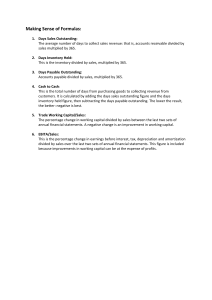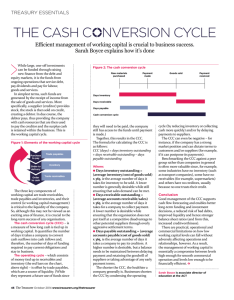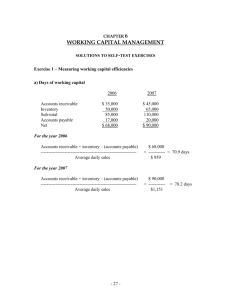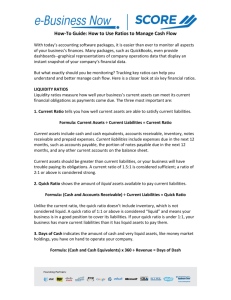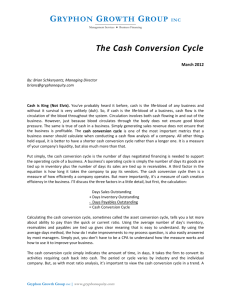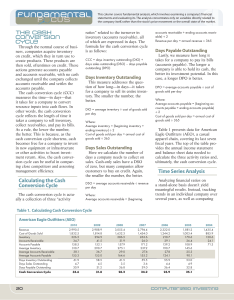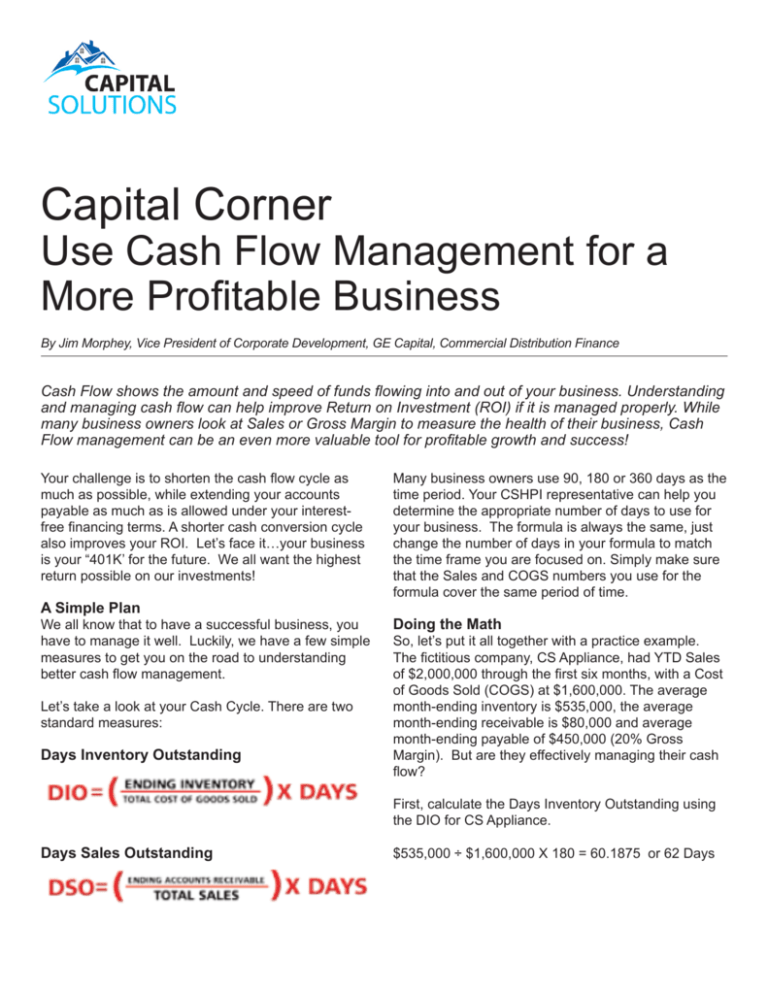
Capital Corner
Use Cash Flow Management for a
More Profitable Business
By Jim Morphey, Vice President of Corporate Development, GE Capital, Commercial Distribution Finance
Cash Flow shows the amount and speed of funds flowing into and out of your business. Understanding
and managing cash flow can help improve Return on Investment (ROI) if it is managed properly. While
many business owners look at Sales or Gross Margin to measure the health of their business, Cash
Flow management can be an even more valuable tool for profitable growth and success!
Your challenge is to shorten the cash flow cycle as
much as possible, while extending your accounts
payable as much as is allowed under your interestfree financing terms. A shorter cash conversion cycle
also improves your ROI. Let’s face it…your business
is your “401K’ for the future. We all want the highest
return possible on our investments!
Many business owners use 90, 180 or 360 days as the
time period. Your CSHPI representative can help you
determine the appropriate number of days to use for
your business. The formula is always the same, just
change the number of days in your formula to match
the time frame you are focused on. Simply make sure
that the Sales and COGS numbers you use for the
formula cover the same period of time.
A Simple Plan
We all know that to have a successful business, you
have to manage it well. Luckily, we have a few simple
measures to get you on the road to understanding
better cash flow management.
Let’s take a look at your Cash Cycle. There are two
standard measures:
Days Inventory Outstanding
Doing the Math
So, let’s put it all together with a practice example.
The fictitious company, CS Appliance, had YTD Sales
of $2,000,000 through the first six months, with a Cost
of Goods Sold (COGS) at $1,600,000. The average
month-ending inventory is $535,000, the average
month-ending receivable is $80,000 and average
month-ending payable of $450,000 (20% Gross
Margin). But are they effectively managing their cash
flow?
First, calculate the Days Inventory Outstanding using
the DIO for CS Appliance.
Days Sales Outstanding
$535,000 ÷ $1,600,000 X 180 = 60.1875 or 62 Days
Next, calculate the Days Sales Outstanding using the DSO formula, which gives a result of 7.2 days. Add these
two together (60.2 + 7.2), we arrive at the Cash Cycle, which shows that on average, it takes CS Appliance 67.4
days from the moment they receive the inventory, to sell and receive payment.
Finally, we can compare the Cash Cycle to the Days Payable Outstanding to understand cash flow. The formula
for understanding DPO is similar to the other two:
Days Payable Outstanding
$450,000 ÷ $1,600,000 X 180 = 50.625 days
When we compare the difference between our Cash Cycle (67.4 days) and our Payables (50.6 days), we find a
cash conversion rate of 16.8 days. CS Appliance is paying funds out almost 17 days faster than it is converting
inventory and accounts receivable to cash.
Matching Turn to Terms
Comparing your Cash Cycle to your Accounts Payable Cycle and calculating your cash conversion rate on a
quarterly – or even monthly – basis can help you better understand your cash flow. By ensuring your inventory
turns are matched closely to your payment terms, your cash flow is increased and your business has more
liquidity.
Jim Morphey is the Vice President of Corporate Development for GE Capital,
Commercial Distribution Finance. Jim has more than 40 years of management
experience in Trade Credit as well as the floor plan, factoring, and consumer finance
business devoted almost entirely to the domestic consumer electronic, appliance, and
outdoor power industries. His background includes assignments in Operations, Credit,
Sales Management at the national level with Whirlpool, Whirlpool Financial Corporation,
Transamerica Distribution Finance, and GE Capital. Jim is a 1974 graduate of Northern
Illinois University with a B.S. in Management. He is a member of AFP (Association for
Finance Professionals) and earned Certified Credit Executive (CCE) certification from the
NACM/CRF (National Association of Credit Management/Credit Research Foundation)
Graduate School of Credit & Financial Management at Dartmouth. He also received his
Certification as an International Credit Professional from FCIB (The Association of
Executives in Finance Credit and International Business). He resides with his family in
Southwestern Michigan.
IMPORTANT NOTICE: This article should not be considered specific financial advice for your business. If you have questions about managing your business,
please contact your financial consultant. This publication provides general information and should not be used or taken as business, financial, tax, accounting,
legal or other advice, or relied upon in substitution for the exercise of your independent judgment. For your specific situation or where otherwise required, expert
advice should be sought. The views expressed in these articles reflect those of the authors and contributors and not necessarily the views of GE Capital or any
of its affiliates (together, “GE”). Although GE believes that the information contained in this publication has been obtained from and is based upon sources GE
believes to be reliable, GE does not guarantee its accuracy and it may be incomplete or condensed. GE makes no representation or warranties of any kind
whatsoever in respect of such information. GE accepts no liability of any kind for loss arising from the use of the material presented in this publication.
©2011 General Electric Capital Corporation. All rights reserved

